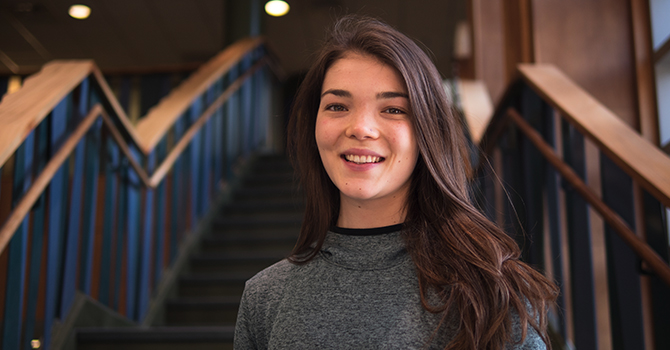Saving Athletes Strife and Stress: A Student-Athlete’s Path to Prevention

Traci Carson
PhD Pre-Candidate, Epidemiology; MPH, ‘17, HBHE
In my undergraduate years, I would've never said the words "anxiety" or "eating disorder" to describe my situation. From a young age I had a disordered relationship with food and eating, and I'd started experiencing the symptoms of anxiety my freshman year, but I had no idea what it all was. I would avoid social situations that involved large groups or were centered around food because I was so rigid about my diet and feared not having control over food. My sophomore year, I went into my most severe period of disordered eating, which exacerbated the anxiety even more. I hid behind labels like "paleo" and "athlete" to explain the disordered behavior away.
Then, when I came to Michigan as a transfer student in my sophomore year, it was hard to be the new girl. As a member of the Michigan Rowing Team, I had a rowing community, but it was a new school, new major, new teammates, and a competitive athletic environment that, unfortunately, didn't bode well for me. It wasn't until I left the rowing team that it became clear I wasn't emotionally stable around food, and that I was combining that with a dangerous low-energy state for my body. At my annual physical that year, my blood tests came back and my estrogen levels were menopausal. Hearing the words, "You're a 20-year-old with the profiles of someone much older" hit me like a brick. It was a clear sign I needed to change, but it wasn't so easy to go from that data to making a change.
I didn't know what public health was until my junior year. I was in sports management in the School of Kinesiology, and I thought I was going to be an athletic director. But I did some internships, and wasn't thrilled with the business world. That year, my brother—he's a year older than me—took a public health class. He loved it and told me, "Traci, you need to take this." So in the winter, I took Public Health 200, the introduction to public health class with Ken Warner. The framework of prevention stuck out. Suddenly, here are all these opportunities to prevent all these diseases in our society, starting in the social-economic spaces we grow up in. The next year, I applied to Michigan Public Health to pursue my master's degree in public health.
During the MPH program at Michigan Public Health, I started gaining awareness that my situation wasn't unique in the student-athlete community. I realized the lack of information I had available to me along the way as an athlete, even with doctors I would talk to. They were never getting to the root causes. That's anti-public health: "Just put a bandaid on it." But that inspired me to find more answers—to solve these issues through a public health framework so numerous other women I knew, and many I didn't, would know about these health issues and have options. That led me to focus on the Female Athlete Triad (TRIAD), which is how the female body adapts physiologically to the stresses of low energy availability and to physical and psychological stress. (Learn more from Traci about the TRIAD in this video).
After an internship at Harvard, I really fell in love with the data and analysis side of public health. That inspired me to go into epidemiology for my PhD, when I finished my Master of Public Health (MPH) in our Health Behavior and Health Education department. As an epidemiologist, I don't want to design interventions with athletes yet, but I want to dig into the data and the research and say, "This is where we need the interventions." From a public health perspective, there's a huge opportunity. If we can intervene really early at the first sign of the TRIAD and get the athlete the help that they need—whether that's a doctor, therapist, or nutritionist—we can prevent a lot of strife, and save athletes a lot of stress. Hopefully, we'll be able to prevent season-ending injuries, and avoid the psychological stress an athlete feels being taken out of their sport.
I love Michigan because I'm so attracted to the integration of medicine, public health, and kinesiology. This world I've found myself in is incredible—seeing how the departments at Michigan Public Health, for example, truly want to work together, collaborate, interact, and share resources. I love that, because I think we can all learn so much from each other. It makes me very proud to wear the Block M wherever I go, because it represents this idea that people want to connect with each other, collaborate. That gives me so much energy. It really fires me up.
